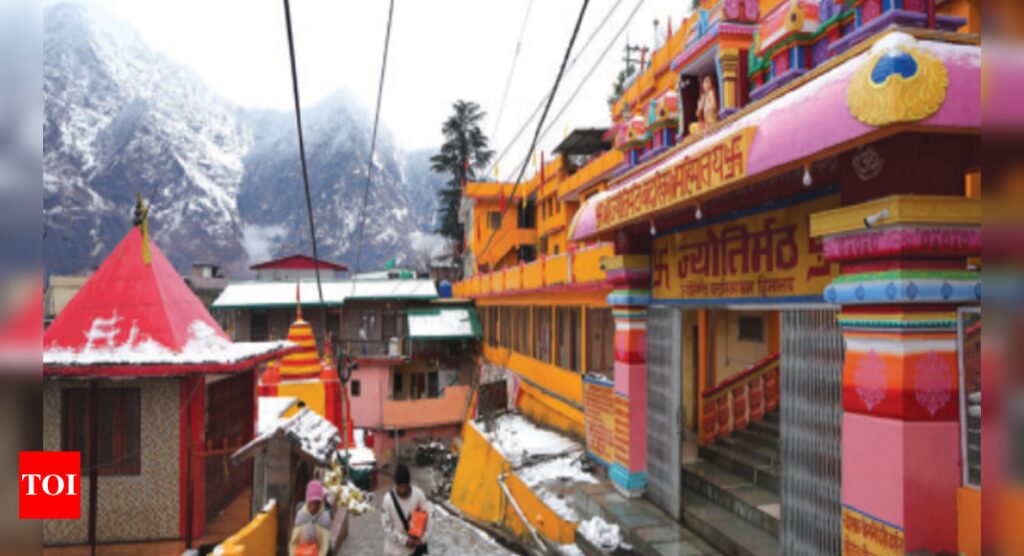[ad_1]
DEHRADUN: Hyderabad-based National Geophysical Research Institute (NGRI), a research laboratory of Council of Scientific and Industrial Research (CSIR), in its 43-page report on Joshimath subsidence, has claimed that certain areas of the town “sunk vertically by over 3 feet and moved by 1.4 feet”.
The NGRI was among the eight specialised scientific and technical institutions mandated to ascertain the causes of ground subsidence in the area in and around Joshimath and carry out remedial measures. The report, which was kept ‘secret’ by the state government for months and made public only recently, pointed to “steep, air-filled fissures extensively developed and extending to a depth exceeding 100ft”.
It claimed: “The fissures on barren and agricultural land were as deep as 115ft and become shallower and tangential at 60-65ft depth towards lower reaches of the subsidence-hit town.”
“Maximum horizontal displacement along the fissures were observed in Sunil, Manohar Bagh and Singhdhar with displacement as high as 45cm (1.4ft). Vertical displacement (sinking) as high as 110-110cm (3.6ft) was witnessed in Singhdhar and Marwari,” the NGRI report said.
While carrying out a detailed mapping of the cracks on the ground, the NGRI scientists found the fissures were distributed from the upper slopes of Sunil village having an altitude of 2,200m to Marwari-Jaypee region at the toe of Joshimath slope, situated at a height of 1,400m. NGRI experts said “the fissures were mostly confined to the gently sloping built-up areas.”
An expert at Uttarakhand SDMA, requesting anonymity, told TOI, “The fissures extending up to over 100ft depth were found in areas having loose soil cover and there was no presence of rocks beneath the surface.”
It was observed that the larger displacement along the fissures was confined to the region having thick sediment cover in comparison to the hard-rock areas.
The report went on to add that the subsidence was observed “in the middle and western side of Joshimath with peak subsidence in the north-north-west/south-south-east narrow zone of the town”. The NGRI report added: “Land cover analysis of satellite data revealed the percentage of built-up area footprint from 1.25 sqkm to 2.5 sqkm between 2010 and 2020, a 100% increase within a decade.”
The NGRI was among the eight specialised scientific and technical institutions mandated to ascertain the causes of ground subsidence in the area in and around Joshimath and carry out remedial measures. The report, which was kept ‘secret’ by the state government for months and made public only recently, pointed to “steep, air-filled fissures extensively developed and extending to a depth exceeding 100ft”.
It claimed: “The fissures on barren and agricultural land were as deep as 115ft and become shallower and tangential at 60-65ft depth towards lower reaches of the subsidence-hit town.”
“Maximum horizontal displacement along the fissures were observed in Sunil, Manohar Bagh and Singhdhar with displacement as high as 45cm (1.4ft). Vertical displacement (sinking) as high as 110-110cm (3.6ft) was witnessed in Singhdhar and Marwari,” the NGRI report said.
While carrying out a detailed mapping of the cracks on the ground, the NGRI scientists found the fissures were distributed from the upper slopes of Sunil village having an altitude of 2,200m to Marwari-Jaypee region at the toe of Joshimath slope, situated at a height of 1,400m. NGRI experts said “the fissures were mostly confined to the gently sloping built-up areas.”
An expert at Uttarakhand SDMA, requesting anonymity, told TOI, “The fissures extending up to over 100ft depth were found in areas having loose soil cover and there was no presence of rocks beneath the surface.”
It was observed that the larger displacement along the fissures was confined to the region having thick sediment cover in comparison to the hard-rock areas.
The report went on to add that the subsidence was observed “in the middle and western side of Joshimath with peak subsidence in the north-north-west/south-south-east narrow zone of the town”. The NGRI report added: “Land cover analysis of satellite data revealed the percentage of built-up area footprint from 1.25 sqkm to 2.5 sqkm between 2010 and 2020, a 100% increase within a decade.”
[ad_2]
Source link











More Stories
Congress replaces Kamal Nath, names an OBC as Madhya Pradesh chief | India News
Fire breaks out in ITBP camp in Srinagar; none hurt | India News
Parliament Security: Co-villagers give clean chit to Lalit Jha, parents to move court | India News